Abstract
We report on the simulation of temperature gradients in tamped NaFMgO target-foil plasma, heated and backlit by z-pinch dynamic hohlraum radiation. Our approach compares the spectroscopic output of a collisional-radiative model (prismspect) with soft X-ray absorption spectra collected on Sandia National Laboratories’ (SNL) Z Pulsed Power Facility. The pattern of minimum is seen to agree with an efficient, three-parameter model. Results show that a negligible gradient in electron temperature is consistent with experimental data, justifying the assumptions of previous work. The predicted sensitivity of line spectra to the gradient-aligned profile of is documented for each spectral feature, so that the line-area ratio between a pair of spectral features may be assessed as a proxy for the existence and quantification of such gradients.
1. Introduction
The need for accurate diagnosis of the temperature and density of a high-energy-density (HED) plasma via spectroscopic means is well-reported [1,2,3]. In particular, to study the characteristics of massive accretors such as X-ray binaries or active galactic nuclei (AGN), the astrophysical community relies on the analysis of emission from the associated accretion-powered plasma [4]. Such distant, photoionized plasmas pose a formidable challenge to models and have provided an insight into where theories must improve [5].
When confronted with these complex systems, it is quite reasonable to exclude effects due to inhomogeneity and/or non-stationarity for simplicity. Indeed, numerical experiments have buttressed the validity of these assumptions in particular regimes. In ref. [6], for example, the authors conclude that corrections due to spatial temperature gradients are negligible for all transitions with wavelength Å, which exceeds the highest wavelength of interest. Unfortunately, recent work [7] asserts that an assumption of stationarity is ill-founded in many scenarios involving HED plasma. Moreover, a systematic investigation of the effect of spatial gradients on spectroscopic diagnoses of temperature and density has not yet been explored.
In this study, we implement the collisional-radiative model prismspect [8] to construct synthetic absorption spectra, which are subsequently compared with data gathered from the Z Facility at SNL. In line with previous work that utilized line-area ratios to infer electron temperature in a radiatively-heated NaFMgO plasma [9,10], we investigate the robustness of line-area ratios in the presence of spatial gradients.
Specifically, when these ratios compare relatively high-energy atomic transitions to low-energy transitions (e.g., Mg He- to F He-), we observe monotonic functions of temperature difference . This relationship may provide a spectroscopic diagnosis for spatial gradient magnitude, though knowledge of the average electron temperature must be known a priori. For the reason that is likely to also be inferred via line-area ratios, it is paramount to categorize the sensitivity of these ratios to changes in both and .
Effectively, this report is an extension of line-ratio techniques documented in refs. [9,10,11] and elsewhere. Section 2 outlines the experimental set-up, while Section 3 details our hypothesis and various methods of data reduction. Section 4 provides a discussion of the implications and applications of our work.
2. Materials and Methods
The experiments were performed on the Z Facility at SNL [12], using the Z Pinch Dynamic Hohlraum (ZPDH) [13], under the auspices of the Z Astrophysical Plasma Properties (ZAPP) collaboration [14]. As the materials and methods have been documented elsewhere [9,10], we provide only a summary of the experimental scenario. In particular, the ZPDH consists of a 120 tungsten wire array with an inner diameter of 20 mm, nested in a 240 tungsten wire, 40 mm diameter array [14]. A cylindrical, 6 mm diameter, 14.5 mg/cm CH foam fits in the center of the inner array [15]. Current in excess of 26 MA, provided by discharging 36 Marx capacitor banks in parallel [16], flows through the wire arrays over a 100 ns interval, with peak current lasting approximately 3 ns [10]. Driven by the force, ablated tungsten streams towards the z-pinch axis until stagnation, driving a radiating shock through the foam [15]. Due to the high opacity of the tungsten plasma, the shock radiation is trapped, effectively creating a hohlraum [9,15]. Crucially, this “dynamic” hohlraum can facilitate total X-ray energy and power exceeding 1.5 MJ and 200 TW, respectively [14,17].
The target foil was mounted 2.65 cm from the z-pinch cylindrical axis, glued directly to the Return Current Can (RCC) (see Figure 1). This configuration furnishes the minimum distance from the pinch axis, which also leaves intact the implicit azimuthal symmetry.
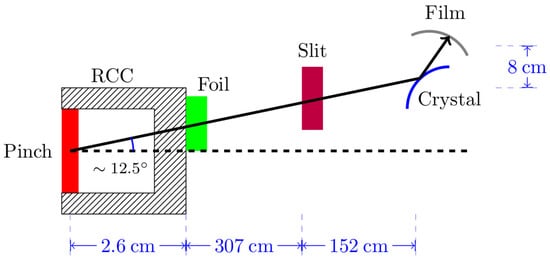
Figure 1.
Schematic of experiment configuration and geometry, showing relative positions of pinch, return current can, target foil, and time-integrated crystal spectrometer. Reprinted from ref. [9], Copyright 2022, with permission from Elsevier.
Each target was fabricated to have 4 m of parylene (CH) tamper on both the front and back sides of 10 repeated double-deposition layers of sodium fluoride/magnesium-oxide foil. The NaF and MgO deposition layers were interleaved within the foil to enhance plasma homogeneity upon expansion [17] (see Figure 2). Foil elements have been chosen with similar atomic numbers (), to minimize the ionization energy required to observe similar charge-state configurations. The oxygen was inadvertently introduced as an impurity during foil fabrication.
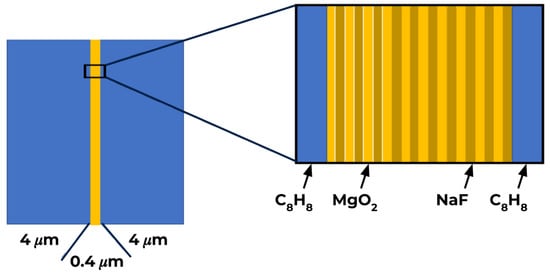
Figure 2.
Representation of the 4-micron-tamped target foil, with inset describing the layered nature of experimental foil. Reprinted from ref. [9], Copyright 2022, with permission from Elsevier.
Absorption spectra are resolved and collected by a time-integrated convex-crystal spectrometer (TIXTL) [18]. The TIXTL consists of two spectrometer arms, one with a 4-inch convex, spherically-bent potassium acid phthalate (KAP) crystal and the other with a 4-inch convex, spherically-bent rubidium acid phthalate (RAP) crystal. In this study, we focus exclusively on data derived from the KAP crystal (i.e., = 7–15 Å, 800–1800 eV). Although the spectrometer is time-integrated, the majority of the signal comes from radiative flux during the 3 ns stagnation, when the pinch is hot and dense enough to produce a large quantity of X-rays (we discuss the likelihood of temporal gradients in Section 4). The TIXTL has a resolving power of in the 7–15 Å range, and is spatially resolving with respect to the axial direction of the pinch. Kodak 2924 X-ray film was used to record the absorption spectra.
3. Results
3.1. Description of Gradient Model
We hypothesize a simple, three-parameter schema for the electron temperature profile across the target-foil plasma. The model parameters are two temperatures, and , in conjunction with the length ratio , where represents the length of the interval in which the temperature is assumed to be constant and equal to (see Figure 3). In essence, we investigate the likelihood of a thin, hot layer on the pinch-facing side of the target-foil plasma. Preliminary work with prismspect, using the more general case of 10 temperatures, predicted a best-fit temperature profile with these characteristics. However, because this may be an artifact of a time-varying temperature, we are motivated to perform the more careful analysis herein. To best reproduce the experimental conditions, we demand that the total length conforms to the measured size of the NaFMgO layer, thus Å [10].
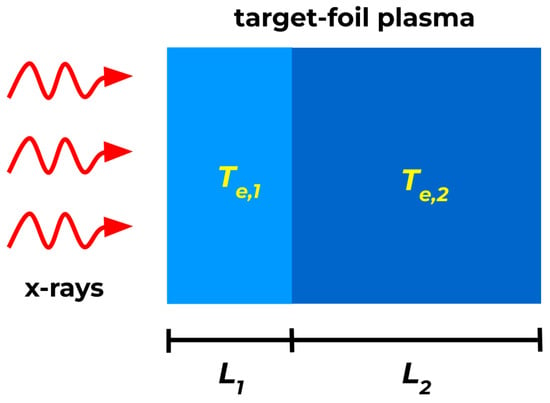
Figure 3.
Cartoon description of tested model, displaying incident radiation and temperature regimes. Here, .
The temperatures and are used as inputs to prismspect in order to compare them with experimental data. The range for both temperatures is 45–75 eV, in steps of 2.5 eV; ion density was fixed at ions/cc. These values are chosen to reflect the results presented in refs. [9,10]. Guided by previous work [4,5,6,9,10,15,17,19,20,21,22], we model our system as 1D, both for simplicity and efficiency. This assumption is reasonable due to the negligible lateral gradients in temperature and density, as two laterally displaced points on the foil see effectively analogous radiation. The use of a 3 mm × 3 mm limiting aperture, placed between the foil and the imaging slit (see Figure 1), serves to reduce edge effects and further justify a 1D simulation. Additionally, we assume local thermodynamic equilibrium (LTE) [1,23]; prior investigations of similar atomic transitions and comparable regimes of temperature and density [17,19,21] imply that the collisional ionization rates are sufficient to validate this assumption. While prismspect incorporates bound-bound, bound-free, and free-free transitions, only bound-bound transitions will be considered when comparing them to the relative (continuum-normalized) transmission obtained from the experiment.
To account for the possibly unequal lengths and , we vary the areal density in each simulation, where is the mass density of the foil. Explicitly, the areal density of the experimental foil is found to be
where is the atomic mass of element x (in amu), and the values of areal abundance are adduced by Rutherford backscattering [10,24,25]. Thus, to simulate a foil with an integral length ratio of , we use the areal densities.
Once both prismspect runs are completed for a given length ratio, the simulated transmission is found using where represents the transmission through a foil with areal density . In this state, the simulated absorption spectra lack the instrument broadening incurred by the experimental data. To account for this, the simulated transmission is convolved with a measured instrument function [20], which incorporates broadening due to finite source size, spectrometer uncertainty, and film limitations [10]. The final simulated transmission is therefore [15]
where is the instrument function, and is assumed to be zero outside the range Å. Figure 4 provides a direct comparison of the experimental and simulated absorption; it is clear from inspection that the modeled amplitudes, relative positions, and line-widths compare well with observation.

Figure 4.
Comparison of transmission vs. wavelength for post-processed experimental data (red) and output of prismspect (blue), using inputs of eV and ions/cc. Notable K-shell transitions are labeled for magnesium, sodium, and fluorine.
Exposed experimental film was digitized and processed in the manner outlined by [9,10]. In short, after alignment, adjustment for film fog, division by continuum emission from the ZDPH, and interpolation, experimental data is given by a single function of transmission versus wavelength (see Figure 4). This absorption spectrum contains, in principle, all the information required to effectively infer both the electron temperature (from line-area ratios) and the ion density (from line broadening) [9,15]. In ref. [9], analysis of isoelectronic line-area ratios determined the electron temperature of a MgFNaO target-foil plasma, fielded on Z Machine shot Z2950, to be eV (hereafter we drop the subscript on ).
3.2. Minimization
The estimation of the experimental electron temperature profile is informed by chi-squared analysis. Specifically, we use the reduced statistic [26]
where and are the experimental and simulated transmissions, respectively, and is the standard deviation of the experimental data, each for a given wavelength . When , derived from prismspect output, is a good fit of the experimental data, the reduced statistic tends to unity, .
Fixing a value of the length ratio , we calculate the reduced chi-squared statistic for each pair of temperatures and , leading to a 2D map . Figure 5 illustrates the evolution of this map as varies from 1 to 4. Of particular salience is the goodness-of-fit in all cases. Across the entire temperature range of interest, varies only slightly, from approximately 1.05 to 1.5. This implies the effect of temperature gradients is subtle, in line with the findings of [6].
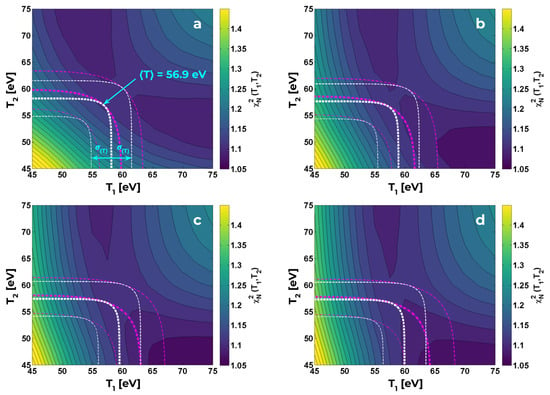
Figure 5.
Contour plot of reduced statistic for (a), 2 (b), 3 (c), 4 (d). Thick curves represent the solution of (5) for eV (magenta dash-dotted) and eV (white dashed); thinner curves bound the range of uncertainty. Notice that shrinking the thin layer (i.e., increasing ) enhances correspondence between curves of eV and minimum .
For clarity, we overlay curves representing the average temperature eV and the corresponding uncertainty , as found via isoelectronic line-area ratios in ref. [9]. Despite ostensibly neglecting the results of inter-stage line-area ratio analysis (see Section 3.3), we will find in Section 3.4 that a spatial temperature gradient is not likely in either case. To compensate for the unequal distribution of temperature, we use the Boltzmann distribution , where p is the population density of emitters with energy E and is the partition function. The average population density of emitters along a line of sight is then
where we assume the differences in charge state distribution are not sufficient to appreciably alter the individual partition functions. Hence, the average temperature for a given transition energy E is calculated by the
using length ratio . For a known , the best-fit temperature profile is inferred by the minimum of along a curve of constant . Broadly speaking, this analysis reports an increase in the likelihood of a spatial temperature gradient as the ratio increases. For example, in Figure 5d, we see that a temperature difference () on the order of 10 eV is consistent with analysis for low-energy transitions ( eV); this is not observed in Figure 5a,b.
3.3. Quantitative Assessment via Line-Area Ratios
In this subsection, quadratic regression is employed to constrain the value of . As in previous analyses [9,10], we convert all absorption spectra (both simulated and experimental) to optical depth , using . Generally, optical depth is a function of wavelength. For a given bound-bound transition with a lower state l and an upper state u, we have
where is the lineshape of the transition, and is the population density of the lower state [15]. Integrating over wavelength, and using , we find
Thus, the integrated area of a particular spectral feature (in optical depth) provides a measurement of population density. Within each charge state, energy levels are distributed according to the Boltzmann relation [15], so increases in electron temperature facilitate the population of higher energy levels. This constitutes the crux of the line-area ratio diagnostic.
Once transmission data are converted to optical depth, each prominent spectral feature is fitted with a pseudo-Voigt profile [27], which is integrated to provide a value of line-area. Despite work demonstrating that more detailed line shapes are superior to Voigt functions (e.g., [19]), the pseudo-Voigt maximizes computational efficiency while also accounting for Stark and Doppler broadening [10,22] (see Figures 7 and 8 in ref. [9] for examples of typical Voigt fits). Pairs of line-areas are formed into ratios, which may be categorized as either isoelectronic or inter-stage. Isoelectronic ratios compare similar electronic transitions in different elements (e.g., Mg He- and F He-) [11], while inter-stage ratios compare different transitions within the same element (e.g., Na He- and, Na He-) [28].
Plotting line-area ratios determined from prismspect data as a function of , we observe monotonic behavior (see Figure 6). For simplicity, we fix the value of eV, which, in view of (5), implies that varies as we adjust . Performing a quadratic least-squares fit [26] to each simulated ratio yields an invertible function that delineates the inferred value of , based on the measured value of the line-area ratio (cf. Section 4 in [9]). Figure 6 elucidates this procedure for the line-area ratio of Mg He- to F He-.
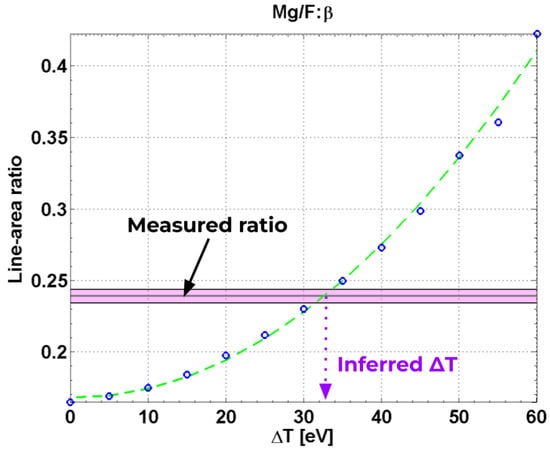
Figure 6.
Quadratic regression analysis of the isoelectronic Mg He-/F He- line-area ratio vs. . Best-fit line is shown in green, while data derived from prismspect are shown as blue circles. Measured ratio from experiment is shown as a horizontal line; shading around this line represents the standard error ().
Each ratio furnishes a value of temperature change and an associated standard error (i.e., ). We calculate the weighted mean and unbiased weighted variance via [26].
The effective degree of freedom is used to compensate for large deviations in uncertainty from one line-area ratio to another. In the limit where a single uncertainty vanishes , we see that tends to unity, and the uncertainty in the weighted mean becomes the population’s standard deviation (though, in the case where , we recognize that is formally singular). This is readily observed by comparing the dash-dotted lines (standard deviation) with the dashed lines (uncertainty in the weighted mean) in Figure 7 and Figure 8.
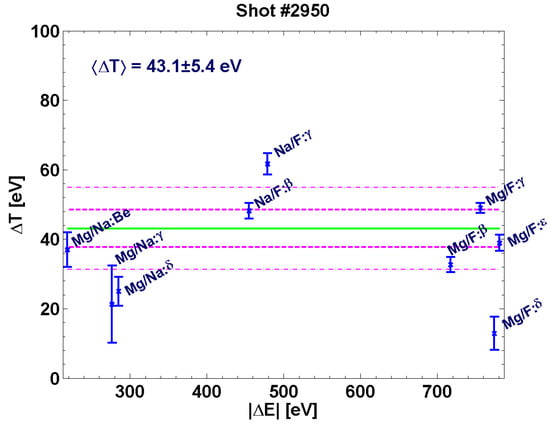
Figure 7.
Analysis of isoelectronic line-area ratios from Z shot #2950, plotted as a function of energy difference . Inferred from inversion of quadratic fit is plotted for each pair of spectral features as blue ×, with error bars for uncertainty. Weighted mean is given in green; magenta dash-dotted lines represent the uncertainty of the data-set, while magenta dashed lines illustrate uncertainty in weighted mean. Convention for naming ratios is ‘<element 1>/<element 2>:<transition>’.
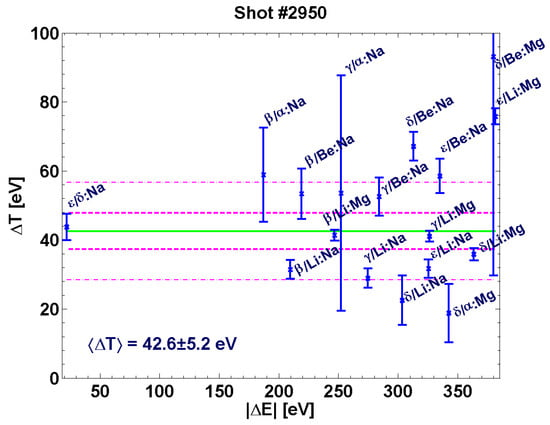
Figure 8.
Analysis of inter-stage line-area ratios from Z shot #2950, plotted as a function of energy difference . Inferred from inversion of quadratic fit is plotted for each pair of spectral features as blue ×, with error bars for uncertainty. Weighted mean is given in green; magenta dash-dotted lines represent the uncertainty of the data-set, while magenta dashed lines illustrate uncertainty in weighted mean. Naming convention is ‘<transition 1>/<transition 2>:<element>’.
Notably, we recognize agreement between the weighted means as inferred by isoelectronic and inter-stage ratios, which is contrary to the results for temperature in refs. [9,10]. However, the calculated value of (≈43 eV) stands in disagreement with that obtained via analysis; notice that we may rewrite (5) as , where , and
3.4. Sensitivity of Individual Line-Area Ratios
The previous subsection attempted to infer, using a catalog of prismspect data, a value of that comports with experimental measurements of line-area ratios. Unfortunately, to obtain invertible functions of , we fixed the value of which led to the aforementioned disparity. Thus, it behooves our interpretation to individually assess the dependency of a given line-area ratio with respect to the two temperatures . Effectively, we seek a 2D generalization of the previous subsection’s methodology. To construct this, we first present maps of for various line-area ratios using prismspect (see Figure 9).
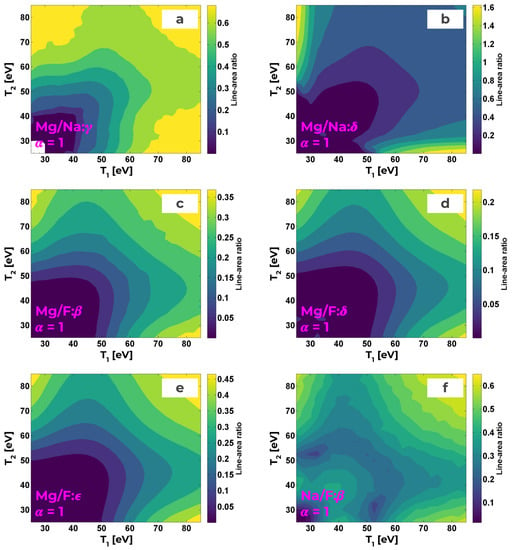
Figure 9.
Contour plot of line-area ratio for Mg He-/Na He- (a), Mg He-/Na He- (b), Mg He-/F He- (c), Mg He-/F He- (d), Mg He-/F He- (e), Na He-/F He- (f). Note that these are taken from a symmetric simulation ().
These maps are then transformed using
where , are ratios derived from experimental and simulated measurements, respectively, and is the experimental uncertainty. An example for the Mg He-/Na He- ratio is given in Figure 10. Thus, approaches unity where the experimentally-measured ratio corresponds to the output of prismspect, .
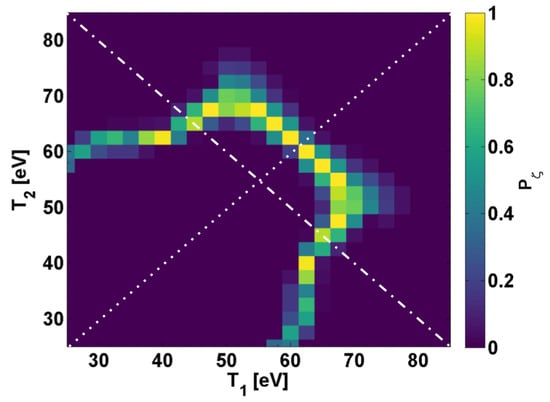
Figure 10.
Map of line-area ratio Mg He-/Na He- as a function of . Dotted line () connects with methodology and results of [9,10], while dash-dotted line () is related to regression performed in Section 3.3.
Notice that both the results of [9] and Section 3.3 are couched within the analysis reported in Figure 10.
Explicitly, along the dotted line (), the peak of provides the inferred value of (i.e., eV); similarly, we see that eV, gleaned from the Mg He-/Na He- ratio (see Figure 7), is given by the peak in along the dash-dotted line (). The ambiguity implicit in choosing a particular line-out for these maps further motivates the holistic approach detailed in this subsection.
Figure 11 illustrates for six line-area ratios in the symmetric case ().
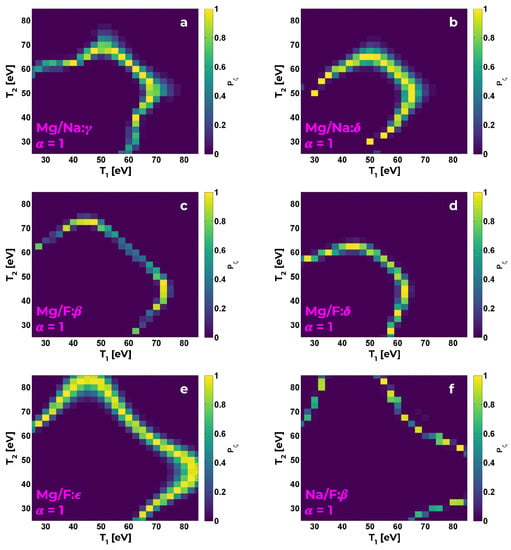
Figure 11.
Visualization of , using (9), for Mg He-/Na He- (a), Mg He-/Na He- (b), Mg He-/F He- (c), Mg He-/F He- (d), Mg He-/F He- (e), Na He-/F He- (f). Conspicuous symmetry across is due to .
Roughly speaking, we observe similar peaks along , which supports the determination of in ref. [9]. For the asymmetric cases, Figure 12 visualizes the change of as is varied from .
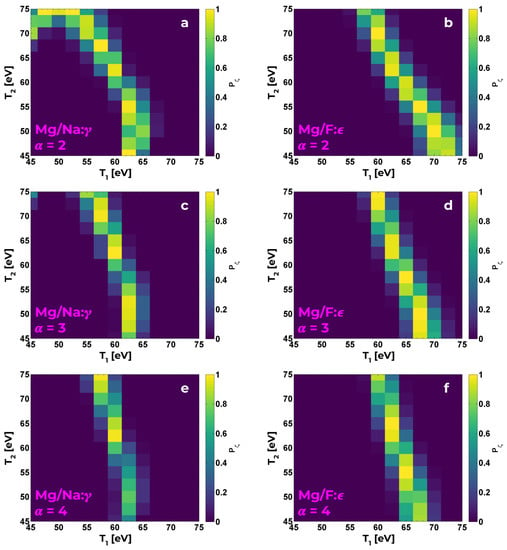
Figure 12.
Evolution of for Mg He-/Na He- (a,c,e) and Mg He-/F He- (b,d,f), as length ratio is varied from (a,b), (c,d), and (e,f). Note difference in domain from Figure 11.
Notice that these maps consider only the temperature range to reduce computational overhead instead of the used heretofore. To concisely visualize the overlap of for all considered line-area ratios, we calculate the mean
Figure 13 reports maps of for .
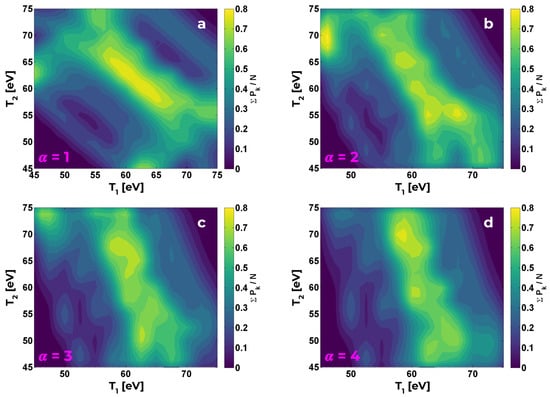
Figure 13.
Smoothed plots of for (a), 2 (b), 3 (c), 4 (d). Note that homogeneous scenario ( is supported in all cases.
Note that we have smoothed these data by convolving with a small kernel, , where .
Plots of , while convenient for contemplating the structure of across many line-area ratios, fail to aptly quantify the best-fit temperature profile. However, for independent random variables with corresponding probability distributions and variance , the distribution of the sum is given by the convolution , with variance . Therefore, by treating the individual as (unnormalized) probability distributions with support on , we sequentially convolve these to produce the (unnormalized) distribution for the sum,
which is presented in Figure 14.
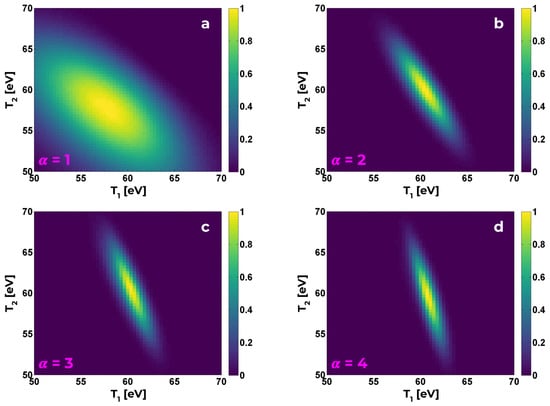
Figure 14.
Convolutions of distributions , normalized by maximum value, for length ratios (a), 2 (b), 3 (c), 4 (d). Axes have been scaled by the number of contributing ratios to provide an estimate of the mean distribution. The tuple of the best-fit temperature profile is found where the distribution peaks; uncertainty is proportional to the full-width at half-maximum (FWHM). Domain has again changed to accommodate available temperature range.
Crucially, this analysis advocates for the absence of a temperature gradient in the target-foil plasma, as each distribution is centered on eV. As the length ratio increases, the mean temperature distribution rotates in space but does not displace from this center-point within uncertainty.
Interestingly, we see that this analysis, which is exclusively concerned with isoelectronic line-area ratios, is in accord with the temperature as inferred by inter-stage line-area ratios in ref. [9] (i.e., eV).
4. Discussion
In this work, we present an investigation of spatial-gradient-effects on the diagnosis of temperature via line-area ratios. Experimentally, a 26 MA z-pinch was utilized to heat and ionize a tamped, layered foil of NaFMgO; X-ray film recorded the absorption spectrum in the interval 7–15 Å, as broadcast by a time-integrated crystal spectrometer. Soft X-ray emission from the stagnating z-pinch served as a broadband backlighter for approximately 3 ns. Acquired data is well-resolved in wavelength and free from obvious defects.
We find that the experimental absorption spectrum is well-fitted by the collisional-radiative model prismspect after simulated data is post-processed to include the effect of instrument broadening. Previous work is leveraged to determine the likely values of average temperature and density.
A reduced statistic is implemented to evaluate the goodness-of-fit between a three-parameter model of foil temperature and experimental absorption spectra. Experimentally-derived values of are consistent with a “small” change in temperature eV across the target-foil plasma.
Quadratic regression of line-area ratio as a function of was performed for both inter-stage and isoelectronic ratios. In contrast to previous results [9,10] which highlighted a discrepancy between temperatures inferred using these ratios, the current study finds agreement (within uncertainty) for the determination of .
To connect the regression analysis with previous work, we generalized our methodology to assess 2D maps of line-area ratio as functions of the two temperatures . The results of both [9,10] and Section 3.3 are succinctly explained by this holistic approach, and consolidation of the 2D results is shown to support a negligible gradient in temperature.
Hence, we conclude that a spatial gradient in temperature is inconsistent with experimental data, under the assumption that our three-parameter model provides a realistic analogy to the experiment. Nonetheless, we have tacitly assumed there are no appreciable effects due to temporal gradients, despite the time-integrated nature of our spectrometer. Thus, future work will consider the consequences of relaxing our assumption of stationary temperature (i.e., allowing ).
Author Contributions
Conceptualization, M.E.K. and T.S.L.; Data curation, T.S.L.; Formal analysis, G.A.R., M.E.K., T.S.L., T.E.S. and P.M.K.; Funding acquisition, M.E.K.; Methodology, G.A.R., M.E.K., T.E.S. and P.M.K.; Project administration, M.E.K.; Resources, I.E.G.; Software, I.E.G.; Supervision, M.E.K.; Validation, M.E.K., T.E.S. and P.M.K.; Visualization, G.A.R.; Writing—original draft, G.A.R.; Writing—review & editing, G.A.R., M.E.K., T.S.L., T.E.S. and P.M.K. All authors have read and agreed to the published version of the manuscript.
Funding
This work was supported by DOE-NNSA Joint Program in High-Energy-Density Plasma Science (DE-NA 0003874), from Department of Energy grant DE-SC-0012515, and from the U.S. Department of Energy, Office of Science, Office of Workforce Development for Teachers and Scientists, Office of Science Graduate Student Research (SCGSR) program. Sandia National Laboratories is a multi-mission laboratory managed and operated by National Technology and Engineering Solutions of Sandia, LLC, a wholly owned subsidiary of Honeywell International, Inc., for DOE’s National Nuclear Security Administration under contract 320 DE-NA-0003525. This work was performed by the Los Alamos National Laboratory, operated by Triad National Security, LLC for the National Nuclear Security Administration (NNSA) of U.S. Department of Energy (DOE) under contract 89233218CNA000001.
Institutional Review Board Statement
Not applicable.
Informed Consent Statement
Not applicable.
Data Availability Statement
Data is available upon request from the corresponding author.
Acknowledgments
Collaboration with J. Bailey, G. Loisel, T. Nagayama, and G. Rochau, all from Sandia National Laboratories, is gratefully acknowledged. Support from the Z Facility support team was essential and appreciated. This material is based upon work supported by the Office of Science Graduate Student Research (SCGSR) program. The SCGSR program is administered by the Oak Ridge Institute for Science and Education (ORISE) for the DOE. ORISE is managed by ORAU under contract number DE-AC05-06OR23100.
Conflicts of Interest
The authors declare no conflict of interest. The funders had no role in the design of the study; in the collection, analyses, or interpretation of data; in the writing of the manuscript; or in the decision to publish the results.
Abbreviations
The following abbreviations are used in this manuscript:
| AGN | active galactic nuclei |
| HED | high-energy-density |
| KAP | potassium acid phthalate |
| LTE | local thermodynamic equilibrium |
| RAP | rubidium acid phthalate |
| RCC | return current can |
| TIXTL | time-integrated convex-crystal spectrometer |
| ZPDH | z-pinch dynamic hohlraum |
References
- Griem, H. Validity of Local Thermodynamic Equilibrium in Plasma Spectroscopy. Phys. Rev. 1963, 131, 1170. [Google Scholar] [CrossRef]
- Salzmann, D. Atomic Physics in Hot Plasmas; Oxford University Press: Oxford, UK, 1998. [Google Scholar]
- Kunze, H.J. Introduction to Plasma Spectroscopy; Springer Science & Business Media: Berlin/Heidelberg, Germany, 2009; Volume 56. [Google Scholar]
- Mancini, R.; Bailey, J.; Hawley, J.; Kallman, T.; Witthoeft, M.; Rose, S.; Takabe, H. Accretion disk dynamics, photoionized plasmas, and stellar opacities. Phys. Plasmas 2009, 16, 041001. [Google Scholar] [CrossRef]
- Loisel, G.P.; Bailey, J.E.; Liedahl, D.; Fontes, C.; Kallman, T.; Nagayama, T.; Hansen, S.; Rochau, G.; Mancini, R.C.; Lee, R. Benchmark experiment for photoionized plasma emission from accretion-powered X-ray sources. Phys. Rev. Lett. 2017, 119, 075001. [Google Scholar] [CrossRef] [PubMed]
- Nagayama, T.; Bailey, J.; Loisel, G.; Rochau, G.; MacFarlane, J.; Golovkin, I. Numerical investigations of potential systematic uncertainties in iron opacity measurements at solar interior temperatures. Phys. Rev. E 2017, 95, 063206. [Google Scholar] [CrossRef] [PubMed]
- Loisel, G.; Bailey, J.; Nagayama, T.; Dunham, G.; Gard, P.; Rochau, G.; Colombo, A.; Edens, A.; Speas, R.; Looker, Q.; et al. Transforming the opacity science on Z using novel time-resolved spectroscopy. Presented at the 64th Annual Meeting of the APS Division of Plasma Physics, Spokane, WA, USA, 17–21 October 2022; Available online: https://meetings.aps.org/Meeting/DPP22/Session/BI02.3 (accessed on 23 June 2023).
- MacFarlane, J.; Golovkin, I.; Wang, P.; Woodruff, P.; Pereya, N. SPECT3D—A Multi-Dimensional Collisional-Radiative Code for Generating Diagnostic Signatures Based on Hydrodynamics and PIC Simulation Output. High Energy Density Phys. 2007, 3, 181–190. [Google Scholar] [CrossRef]
- Lane, T.; Koepke, M.; Kozlowski, P.; Riggs, G.; Steinberger, T.; Golovkin, I. Establishing an Isoelectronic Line Ratio Temperature Diagnostic for Soft X-ray Absorption Spectroscopy. High Energy Density Phys. 2022, 45, 101019. [Google Scholar] [CrossRef]
- Lane, T.S. Evaluation of X-ray Spectroscopic Techniques for Determining Temperature and Density in Plasmas; West Virginia University: Morgantownm, WV, USA, 2019. [Google Scholar]
- Marjoribanks, R.; Richardson, M.; Jaanimagi, P.; Epstein, R. Electron-temperature measurement in laser-produced plasmas by the ratio of isoelectronic line intensities. Phys. Rev. A 1992, 46, R1747. [Google Scholar] [CrossRef]
- Spielman, R.; Breeze, S.; Deeney, C.; Douglas, M.; Long, F.; Martin, T.; Matzen, M.; McDaniel, D.; McGurn, J.; Nash, T.; et al. PBFA Z: A 20-MA Z-pinch driver for plasma radiation sources. In Proceedings of the 1996 11th International Conference on High-Power Particle Beams, Prague, Czech Republic, 10–14 June 1996; Volume 1, pp. 150–153. [Google Scholar]
- Sanford, T.W. Overview of the dynamic hohlraum X-ray source at Sandia National Laboratories. IEEE Trans. Plasma Sci. 2008, 36, 22–36. [Google Scholar] [CrossRef]
- Rochau, G.A.; Bailey, J.; Falcon, R.; Loisel, G.; Nagayama, T.; Mancini, R.; Hall, I.; Winget, D.; Montgomery, M.; Liedahl, D. ZAPP: The Z Astrophysical Plasma Properties collaborationa). Phys. Plasmas 2014, 21, 056308. [Google Scholar] [CrossRef]
- Nagayama, T.; Bailey, J.E.; Loisel, G.; Hansen, S.B.; Rochau, G.A.; Mancini, R.; MacFarlane, J.; Golovkin, I. Control and diagnosis of temperature, density, and uniformity in X-ray heated iron/magnesium samples for opacity measurements. Phys. Plasmas 2014, 21, 056502. [Google Scholar] [CrossRef]
- Marx, E. Experiments on the testing of insulators using high voltage pulses. Elektrotechnische Z. 1924, 45, 25. [Google Scholar]
- Rochau, G.A.; Bailey, J.; MacFarlane, J. Measurement and analysis of X-ray absorption in Al and MgF2 plasmas heated by Z-pinch radiation. Phys. Rev. E 2005, 72, 066405. [Google Scholar] [CrossRef] [PubMed]
- Nash, T.; Derzon, M.; Chandler, G.; Fehl, D.; Leeper, R.; Porter, J.; Spielman, R.; Ruiz, C.; Cooper, G.; McGurn, J.; et al. Diagnostics on Z. Rev. Sci. Instrum. 2001, 72, 1167. [Google Scholar] [CrossRef]
- Bailey, J.; Rochau, G.; Mancini, R.; Iglesias, C.; MacFarlane, J.; Golovkin, I.; Pain, J.; Gilleron, F.; Blancard, C.; Cosse, P.; et al. Diagnosis of X-ray heated Mg/Fe opacity research plasmas. Rev. Sci. Instrum. 2008, 79, 113104. [Google Scholar] [CrossRef]
- Loisel, G.; Bailey, J.; Rochau, G.; Dunham, G.; Nielsen-Weber, L.; Ball, C. A methodology for calibrating wavelength dependent spectral resolution for crystal spectrometers. Rev. Sci. Instrum. 2012, 83, 10E133. [Google Scholar] [CrossRef]
- Nagayama, T.; Bailey, J.; Loisel, G.; Rochau, G.; MacFarlane, J.; Golovkin, I. Calibrated simulations of Z opacity experiments that reproduce the experimentally measured plasma conditions. Phys. Rev. E 2016, 93, 023202. [Google Scholar] [CrossRef]
- Nagayama, T.; Bailey, J.; Loisel, G.; Dunham, G.; Rochau, G.; Blancard, C.; Colgan, J.; Cossé, P.; Faussurier, G.; Fontes, C.J.; et al. Systematic study of L-shell opacity at stellar interior temperatures. Phys. Rev. Lett. 2019, 122, 235001. [Google Scholar] [CrossRef]
- Fujimoto, T.; McWhirter, R. Validity criteria for local thermodynamic equilibrium in plasma spectroscopy. Phys. Rev. A 1990, 42, 6588. [Google Scholar] [CrossRef]
- Chu, W.; Liu, J. Rutherford backscattering spectrometry: Reminiscences and progresses. Mater. Chem. Phys. 1996, 46, 183–188. [Google Scholar] [CrossRef]
- Mayer, M. Rutherford backscattering spectrometry (RBS). In Proceedings of the Workshop on Nuclear Data for Science and Technology: Materials Analysis, Trieste, Italy, 19–30 May 2003; Volume 34. [Google Scholar]
- Bevington, P.R.; Robinson, D.K. Data Reduction and Error Analysis; McGraw-Hill: New York, NY, USA, 2003. [Google Scholar]
- Olivero, J.; Longbothum, R. Empirical fits to the Voigt line width: A brief review. J. Quant. Spectrosc. Radiat. Transf. 1977, 17, 233–236. [Google Scholar] [CrossRef]
- Xiangdong, L.; Cheng, W.; Shensheng, H.; Zhizhan, X. Inter-stage line ratio of He-and Li-like Ti emissions for the electron temperature measurement. Plasma Sci. Technol. 2005, 7, 2764. [Google Scholar] [CrossRef]
Disclaimer/Publisher’s Note: The statements, opinions and data contained in all publications are solely those of the individual author(s) and contributor(s) and not of MDPI and/or the editor(s). MDPI and/or the editor(s) disclaim responsibility for any injury to people or property resulting from any ideas, methods, instructions or products referred to in the content. |
© 2023 by the authors. Licensee MDPI, Basel, Switzerland. This article is an open access article distributed under the terms and conditions of the Creative Commons Attribution (CC BY) license (https://creativecommons.org/licenses/by/4.0/).